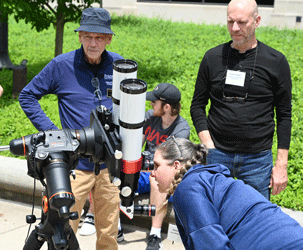Preparing for the Solar Eclipse in the Middle School Classroom
Sunday, June 11th
Optional Sunday night star party (weather dependent)
Monday, June 12th
Morning: 8:45 am Introductions and overview of the day.
MyNASA Data
NASA offers petabytes of global Earth science data collected from satellites but accessing these data in a traditional (or virtual) science classroom can be tricky. Since 2004, My NASA Data has supported students and teachers of grades 3-12 in analyzing and interpreting NASA mission data. My NASA Data as we strive to support your integration of authentic Earth data in your instruction. This session will be led by MyNASA Data Content Manager and Senior Outreach Coordinator/Supervisor, NASA LaRC: Angela (Angie) Rizzi
Observing the Sun During a Total Solar Eclipse
Calculating Ratios of an Eclipse

The Gravity/Universe Model
Adapted from a Saturday Morning Astrophysics at Purdue lesson, this lesson will help us understand gravity and model the distortion of spacetime. This session will be led by Physics and Astronomy's K-12 Outreach Coordinator, David Sederberg.

Exoplanets with Arduinos
How do we know that there are exoplanets out there? Well, in this activity David Sederberg will help us understand one way that scientists detect exoplanets.


More to Light Than Meets the Eye
We can see all the colors of visible light. But did you know light contains many more wavelengths than just what we can see? We use these wavelengths every day. Scientists. Use these wavelengths to research and in remote sensing to find out about many objects such as our sun. For this activity, we will look at what makes white light.
See the lesson plan on the Measuring Visible Light page


Solar Telescope / Pinhole Viewers
How to Safely Observe an Eclipse
2024 Total Solar Eclipse - NASA Pinhole Projector (.zip file)


The outreach team will show a number of different ways to view the sun at the moment as well as during the eclipse.

Department of Physics and Astronomy will have solar telescopes out and lead us in understanding aspects of the Sun.
Tuesday, June 13th
Morning: 8:45 am Overview of the day
Scale model of Earth, Moon, and Sun
Just how far away is the /moon or the Sun from us? David Sederberg will help us get a sense of scale and model a fun activity to do outside with A LOT of space!


Moon phases board
Adapted from The EAPS Virtual Passport Day program, this activity will create a board that students can place over their heads to visualize the moon's phases. This session will be led by Chemistry K-12 Outreach Coordinator Sarah Nern. Link to moon phases board lesson page


GLOBE Cloud training
The sun affects many of Earth's systems. In the session, Angie Rizzi and Sarah Nern go through some GLOBE activities to help us understand clouds.


Link to Sky Conditions mat
Estimating Clouds:
Paper activity Virtual version
GLOBE Observer App
Yep, we have an app for that! Angie Rizzi and Sarah Nern team up again to help us learn how to use the GLOBE Observer app and use it to have students collect data.
Instructions for eTraining:
Make a teacher account and complete the Introduction to GLOBE training. For organization: Please select Purdue V-School
STEP 1: Complete Introduction to GLOBE; Download the module and complete the Assessment Test.
STEP 2: Complete Introduction to Atmosphere (or any of the Intro to “Sphere”)
STEP 3: Complete ONE additional module for that sphere listed under the Intro to Sphere (Clouds, Precipitation, Aerosols, etc)
Download the GLOBE Observer app
GLOBE Observer - Apps on Google Play
Looking Deeper into Atmospheric Science
From particulate matter to celebrating simple instruments, our team will take us through a number of activities.
Up in the Air


Overview of My NASA Data website organization
Angie Rizzi will give us a guided tour of using the My NASA Data resources and help us understand how to use and incorporate some of the vast amounts of data the is available from NASA .
MyNASA Data Solar Eclipse Story Map
In this story map lesson students will learn how living with a star can teach us about our universe. Through a series of learning activities, students will examine the benefits and hazards of living with a star, describe and/or demonstrate how we use eclipses to study the Sun and its features and investigate how our Sun may be used to learn about other stars and our universe.
Data literacy cubes
My NASA Data Literacy Cubes can be used to guide students’ exploration of graphs, data tables, and mapped images of NASA Earth science data. They help students develop their Data Analysis and Interpretation skills, as well as help them to recognize patterns, cause & effect, stability & change, and more.
Discuss the “Day of the Eclipse” plan safety
This session will cover many aspects of safety for schools, students, and communities during an eclipse.
Watch and Share Rafael’s SOS episode!
Creating student accounts
Having students collect data during an eclipse or just as part of a project can be a great learning experience for them. Sarah and Angie will guide us in how to create a GLOBE account for our students to collect and input data for projects. Create and Manage Student accounts



